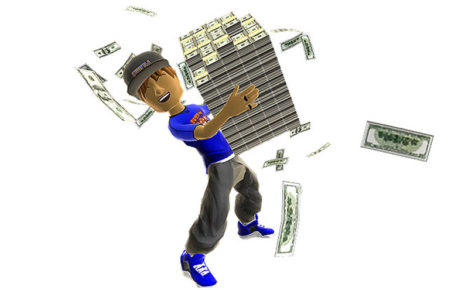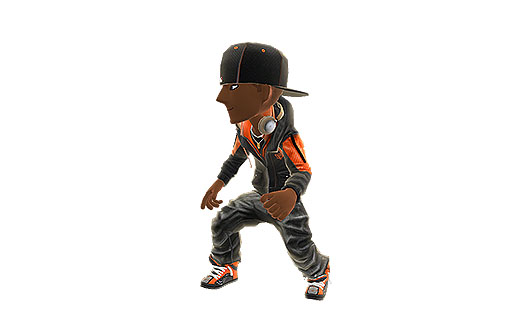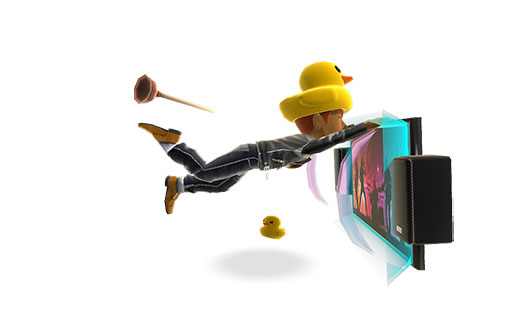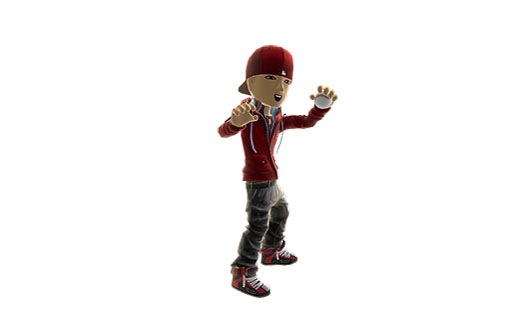Much of technologies, unlike the folks who benefit from them, are boring and sterile by nature; they’re built to do a job and do that job well. It’s a sameness that comes from the designing of a piece of hardware meant for the many instead of the few. People on the other hand are individuals, they have their own tastes, styles and personalities and it’s a trait that doesn’t always mesh well with the uniform devices they’re given. When the PS3s and Xbox 360s arrived on the scene with interfaces that allowed for customization, it was a no brainer sort of venture for a man named Otis Perrick, CEO of Disruptive Publishers, who aimed to fill that need for individuality. Since then, the Vancouver-based company has had a large role in creating much of the customizable content that exists on Xbox Live and the PlayStation Network today and as Perrick implied in a one on one interview, his company shows no signs of slowing down.
FOR THOSE GAMERS OUT THERE THAT DON’T KNOW MUCH ABOUT YOU, DESCRIBE WHAT IT IS THAT YOU OFFER AS A COMPANY. We offer the opportunity for self-expression to personalization. Basically what that is, is that we create over 70 per cent of the avatar content on the Xbox 360 and the majority of the non-gaming themes that you see on the PlayStation 3. To kind of talk about the Xbox marketplace in itself, basically we partnered with the top leagues from the NBA, NHL, MLB, NFL, the top 50 universities to leading mainstream brands such as Puma and we’ve worked with movie studios such as Warner Brothers all the way down to creating original IPs. Why I list all this stuff off is that it’s a vast variety of content that we offer and those offerings allow the consumer an opportunity to express who they are on their avatar which is a true indication and representation of who they are and what they’re playing.
WHAT TRIGGERED THE IDEA BEHIND BUILDING A BUSINESS AROUND VIDEOGAME, FILM, ANIME, ETC. THEMES? Basically it became an idea and an opportunity while I was in my tenure at Electronic Arts. I had worked on the majority of the sports products and had integrated everything from Nike, Reebok shoes and uniforms into NBA products, to music, with the Beastie Boys in NBA Street. It was the crossover of allowing people to have self-expression and showcase who they were that wasn’t in the game. Downloadable content really started at that point where you could unlock things in certain games. As items became available online, you were able to download and have that instant gratification. I contribute the success of both Microsoft and Sony in both realizing that gamers don’t want to buy a console where everyone has the exact same loading screen or interface, they want to be able to change it no differently than the way you’re able to change a phone or the desktop on your computer.
YOU GUYS HAVE OBVIOUSLY BEEN SUCCESSFUL IN THIS VENTURE, WHAT’S THE RECEPTION BEEN LIKE BY GAMERS IN GENERAL? I think gamers love the opportunity to explore and discover on their own and one of the things we’ve done and treaded very carefully with is that we don’t shove anything down our consumers’ and gamers’ throats. The discovery of content, the ability to kind of embrace it on their own, while working with the community, has allowed us to be successful within the gaming realm. The other side of it is that we’re gamers in the office, we’re movie buffs and we’ve got comic book nerds. The studio is built in the same demographic if you will as the consumers we’re trying to reach out to. We build things that we want; we build things that the consumers want.
WHAT KIND OF ARTISTIC STANDARDS DO YOU GUYS HOLD YOURSELVES TO WHEN IT COMES TO PROVIDING THEMES FOR GAMERS? What we try to do is give what we obviously believe is the best foot forward and create something that we’re going to be proud of, that we would have on our own avatars, as far as avatar collections go. When it comes to themes and content, we look at the audience. Some people can’t afford to pay, or don’t want to pay $1.99 or $2.99, so the content will vary and the quality obviously at that point varies in what we’re putting out there and what we provide. The idea is that when you walk into a store, you may not like every shirt that you see, but there’s one in there that hopefully fits and works for you.
HOW DO YOU DECIDE WHICH THEMES TAKE PRIORITY AND HOW MUCH DOES GAMER FEEDBACK PLAY INTO THE PROCESS? Huge. We recently resurrected our Facebook page and I say that because we were kind of silent for awhile there, just trying to get our feet under us and we had an exponential growth. But one of the biggest things is listening to the consumers. For instance, we were bringing on additional universities and we kept getting targeted with Notre Dame alum, and people just kept wondering where Notre Dame was, so we took that down to the collegiate licensing company and told them to look at all of these people. They said no to us a few times for multiple reasons, often good, but when they were able to see that their alum, students and people were just clamoring for it while realizing how successful it was, they jumped on board. We actually got handwritten letters; you just don’t see that anymore, with good penmanship (laughs). We’re consumer based, because without them, we don’t exist.
WHAT’S THE FUTURE FOR AVATARS WITHIN THE TECHNOLOGICAL REALM? I say this with a smile on my face. I don’t think they’re going anywhere. It’s the idea that it’s a representation of who you are and you can go back and look at the successes of original social media if you would from the SimCities to those interactions in PC games that were avatar based at the time. The idea here is that not everyone wants to see a real life picture of you sitting on your coach, but seeing your buddy in an avatar representation wearing his Canucks hoody before you hop into a game of Call of Duty, there’s that interaction and connection. I don’t believe it’s going to go anywhere even as we transition into this cloud digital space. For us it’s exciting because that’s the space we’re in, that’s the space we’ve pioneered, and ultimately, I’ll say it, we’re leaders within the industry.
YOU GUYS MUST BE PRETTY BIG GAMERS, OR NERDS, IN GENERAL TO MAKE A LIVING OUT OF CREATING THE TYPE OF THEMES THAT YOU DO. WHAT’S THE TEAM LIKE AWAY FROM THE OFFICE? When the sun’s out and the summer’s here, we’re outside. You’ll see a lot of guys at lunch, hovered around the TV. They’ve just picked up Madden, so whatever game that’s coming up, whatever sport is on, that’s kind of where we go at. It’s an active group that’s passionate about the industry, at the same time self-aware of everything that’s kind of going on around them, and enjoying the environment that we’re trying to foster here. The team will tell you that they’re self-professed comic book geeks, there’s sports jocks, and the interaction between everyone is what makes this office tick. It’s exciting for me because we’re moving to a new space by the end of the year and that’s just a part of the growth. I contribute everything to these guys.
“I contribute the success of both Microsoft and Sony in both realizing that gamers don’t want to buy a console where everyone has the exact same loading screen or interface.”
ARE THERE ANY DREAM THEMES THAT YOU GUYS HAVEN’T BEEN ALLOWED TO DO? OR THEMES THAT YOU CAN’T WAIT TO DO? PERHAPS SOMETHING “BREAKING BAD” RELATED? (Laughs) You know what, it would all be relevant to the licenses that we’re still trying to land (laughs). Anything is possible, we’re willing to do it, it’s just a matter of actually educating and getting people onboard with it. As long as we’ve been around it’s still an unknown media to a lot of people. Those who make decisions in a media ad or anything like that are mostly in their mid to late 40s, early 50s, they didn’t grow up like we did with gaming, they’re not like the 30 year olds who have the early Playstations and have seen the evolution. It’s us having to educate them.
LASTLY, IT’S BEEN A NAGGING QUESTION, BUT WHY ARE YOU GUYS CALLED DISRUPTIVE PUBLISHERS? (Laughs) There was a gentleman that I worked with; I’ll even say his name, Frank Gibeau, who is now president of EA. He used to say all the time when I was young, to say what it is, say what you’re trying to do when you’re looking at a product. That resonated with me forever and when I started this company, I really wanted to disrupt what was going on. People were talking about disruptive technologies at the time and for me I wanted to publish non-game license content and it hadn’t been done. For me it was like, “I’m going to disrupt it and I’m a publisher,” and that’s who we are. ‘Disruptive’ kind of came from that realm and if you go from seven years ago to today, you hear about it a lot, someone did something they disrupted over here, and that makes me happy.
Interview By. Noel Ransome







Comments are closed.